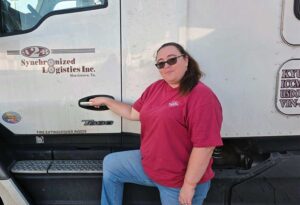From left are Goodyear Marketing Director Gary Medalis, the 2018 Goodyear Highway Hero Award winner, Frank Vieira, and finalists Brian Bucenell and Ryan Moody. (The Trucker: KLINT LOWRY)
LOUISVILLE, Ky. — Brian Bucenell hails from Richmond, Virginia. Ryan Moody calls Tacoma, Washington, home. And Frank Vieira resides in Ancaster, Ontario, about 55 miles (or 89.5 kilometers, as he would say) southwest of Toronto.
You would imagine fate would have to put in some overtime to ever bring these three veteran drivers together for any reason, much less to share a spotlight in Louisville, Kentucky.
Yet there they were. On Thursday, immediately after the first day of the Mid-America Trucking Show, a crowd gathered at the nearby Crowne Plaza Louisville Airport Expo Center hotel to celebrate serendipity’s fait accompli, and three standup guys, as the Goodyear Tire and Rubber Company marked the 35th anniversary of its Highway Hero Award.
Each year since 1983, Goodyear has honored professional truck drivers who perform extraordinary acts of heroism, often at risk to themselves. This year, Bucenall, Moody and Vieira were the three finalists for the award.
Gary Medalis, marketing director for Goodyear, said that over the years, the Highway Heroes award has honored drivers who have saved children’s lives, come to the aid of police officers and have performed numerous other feats of bravery. He added that the three drivers selected as finalists this year are all fine choices as the award — the oldest of its kind in trucking — marks this milestone year.
The incidents that led to these three drivers being nominated for the Highway Hero Award were about as far-flung from one another as their hometowns, with one thing in common: They all exhibited personal and professional cool under pressure.
For Bucenell, it all started just after he’d merged onto the Ohio Turnpike near Toledo. He heard chatter on the CB about a high-speed chase going on somewhere in the vicinity. Moments later, Bucenell saw several state troopers in his rearview mirror chasing a car and gaining on him fast.
Just then, he came upon a construction zone. “We lost the far left lane,” he said. “It went from three lanes to two lanes. They put up a concrete barrier, blocking it off.”
When the car reached Bucenell’s truck another truck was running alongside. Bucenell said the car tried to pass him on the left, saw the barrier, then cut back behind him.
From that point on, Bucenell said, the car kept trying to pass, to the left, to the right, between the two trucks. Every time he moved, Bucenell, who’s been driving professionally for 10 years, moved over just enough to cut him off.
“I know my truck pretty well,” Bucenell said. “It was a mixture of his lack of experience and my knowing my truck. I think that’s what let me be able to stop him.”
Finally, the driver tried to swerve on the shoulder again. “I just whipped it toward the guardrail and stopped,” Bucenell said. The car was trapped, and the chase, which Bucenell later found out had reached 100 mph at one point, was over.
“There were 20 cop cars on him in the blink of an eye. I’ve never seen anything like it,” Bucenell said.
Moody’s incident happened when he was fighting traffic on a Chicago freeway. The only reason he was on that stretch of highway was because he’d missed the turnoff to the highway he had wanted to use.
As he was driving along, three motorcycles passed him. A biker himself, Moody remembered admiring the bikes and thinking, “Man, I wish I was riding right now.”
The motorcyclists got a few car lengths ahead of him, and two of them started to take an exit. As far as he could tell the third biker’s wheels locked up for some reason and he went end-over-end.
Moody said for a split second he was afraid he wouldn’t be able to stop, but he not only stopped but he swerved his truck to block traffic and prevent anyone else from running over the downed biker.
Moody then jumped out of his truck and tended to the unconscious motorcyclist, who was bleeding from a head injury. Moody literally gave him the shirt off his back, wrapping it around the man’s head, while trying to calm down other bystanders who’d stopped.
Moody said he’s ex-military, as was his dad, so all his life it’s been ingrained in him when things “hit the fan, you deal with it.”
Moody stayed with the motorcyclist until paramedics arrived. They later credited him with saving the man’s life.
“One of the officers said, ‘hey, do you want your shirt back?’ I said, no that’s his now.”
Vieira, who marked his 30th anniversary as a driver last year, was driving near Toronto one day when he heard a loud crash on a two-lane stretch of highway, looked over his shoulder and saw that a car on the other side of the road had slammed into the back of a stationary roll-off truck.
Vieira parked his truck, ran to the car, and found the driver, whose neck had been pierced by a piece of his own vehicle’s steering wheel, which had snapped off on impact.
“He had this thing on the right side of the neck, Vieira said.
Immediately, he placed one of his hands over the still-conscious motorist’s wound and applied direct pressure, while using his other hand to call for help. As he was doing this, the driver of the truck that had been hit had walked up, saw the impaled motorist, and fainted. Vieira said he didn’t even notice him until he saw the driver sprawled out on the ground, his legs lying over the line into the opposing lane of traffic. Without letting go of the first driver, Vieira managed to use his foot to pull the leg of the truck driver who had fainted away from traffic. Emergency personnel arrived and took over. Both men survived.
Vieira was surprised it’s become such a big thing, the attention he’s getting. Like the others, he was there and did what needed doing. “It’s a great feeling to be appreciated.”
“When I think about it, it seemed like it took half an hour, but it all happened in maybe four minutes,” Vieira said. He was so in the moment, he’s not even sure how he managed to do everything at once the way he did. “Not much thought goes through your mind; you just do it.”
After the incident he didn’t think much of it, either. “I was actually going to let this fly under the table and not talk about it,” he said. But word got around and before he knew it other people were congratulating him on his heroism. It’s the one aspect of his experience he shares with his fellow nominees.
“I don’t feel like a hero,” Bucenell said. “I didn’t literally safe anybody’s life. I never felt heroic about it. I felt like I did what was right.” When he heard he’d been nominated for the Goodyear Highway Hero award, he first thought one of his buddies was pulling a prank on him.
Moody also downplayed his incident. “To me I was just at the right place at the right time,” he said. “Somebody needed help and I was there. I don’t feel like I need any recognition; I just did the right thing.”
But others felt otherwise, and as it has for the previous 34 years, Goodyear put them in the spotlight. In the end, Vieira was named the winner of the top Highway Hero honor. Days after he heard the decision, he continued to wear the hero’s mantle with humility.
“If it inspires other drivers, great. The more we help, the better this world becomes, right?”
Klint Lowry has been a journalist for over 20 years. Prior to that, he did all kinds work, including several that involved driving, though he never graduated to big rigs. He worked at newspapers in the Detroit, Tampa and Little Rock, Ark., areas before coming to The Trucker in 2017. Having experienced such constant change at home and at work, he felt a certain kinship to professional truck drivers. Because trucking is more than a career, it’s a way of life, Klint has always liked to focus on every aspect of the quality of truckers’ lives.













